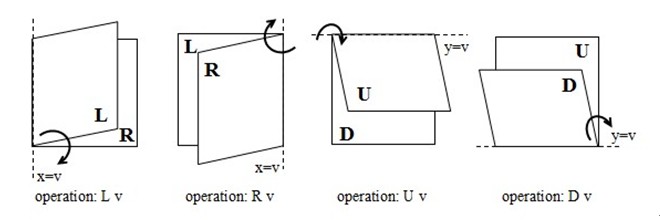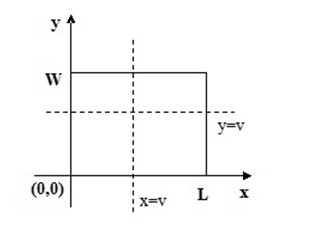当前你的浏览器版本过低,网站已在兼容模式下运行,兼容模式仅提供最小功能支持,网站样式可能显示不正常。
请尽快升级浏览器以体验网站在线编辑、在线运行等功能。
3470:Chinese Paper Folding
题目描述
Chinese Paper Folding, or Zhezhi, is the art of folding paper that originated in China. It is the predecessor of origami.
Here we only consider a simplified problem. You are given a paper L cm by W cm in size and a list of operations to fold it.
Four types of operation are listed below:
1. L v , fold the left part of paper along the straight line x = v.
2. R v , fold the right part of paper along the straight line x = v.
3. U v , fold the upper part of paper along the straight line y = v.
4. D v , fold the lower part of paper along the straight line y = v.
Note that v is always an integer.

We define the left-lower corner of current paper as (0, 0) at every step (refer to the picture below). It is guaranteed that each operation is legal, that is, each operation is asked to fold paper of a positive area.

It is obvious that folding will make the straight lines into creases. We wonder the total length of all creases when paper is completely unfolded.
Here we only consider a simplified problem. You are given a paper L cm by W cm in size and a list of operations to fold it.
Four types of operation are listed below:
1. L v , fold the left part of paper along the straight line x = v.
2. R v , fold the right part of paper along the straight line x = v.
3. U v , fold the upper part of paper along the straight line y = v.
4. D v , fold the lower part of paper along the straight line y = v.
Note that v is always an integer.

We define the left-lower corner of current paper as (0, 0) at every step (refer to the picture below). It is guaranteed that each operation is legal, that is, each operation is asked to fold paper of a positive area.

It is obvious that folding will make the straight lines into creases. We wonder the total length of all creases when paper is completely unfolded.
输入解释
In the first line there is an integer T, indicates the number of test cases. (T <= 50)
For each case, the first line is a pair of integers L and W (1 <= L, W <= 1,000,000), which stands for the length and width of the paper. In the second line, an integer K stands for the number of operations. (K <= 100000) Then K lines follow, each stands for an operation described above.
For each case, the first line is a pair of integers L and W (1 <= L, W <= 1,000,000), which stands for the length and width of the paper. In the second line, an integer K stands for the number of operations. (K <= 100000) Then K lines follow, each stands for an operation described above.
输出解释
For each case, output “Case x: R" on a single line, in which x is the case number counted from one, R is the total length of all creases.
输入样例
2 50 50 4 L 30 D 5 R 3 U 5 65536 1 16 L 32768 L 16384 R 8192 R 4096 L 2048 R 1024 L 512 R 256 R 128 L 64 R 32 R 16 L 8 R 4 L 2 R 1
输出样例
Case 1: 250 Case 2: 65535
来自杭电HDUOJ的附加信息
| Author | love8909 |
| Recommend | zhengfeng |
最后修改于 2020-10-25T23:03:53+00:00 由爬虫自动更新
共提交 0 次
通过率 --%
| 时间上限 | 内存上限 |
| 10000/5000MS(Java/Others) | 65536/32768K(Java/Others) |
登陆或注册以提交代码